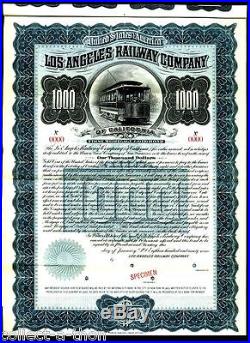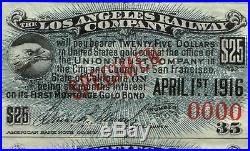


A LIVING PIECE OF L. FREE LOS ANGELES RAILWAY “GOOD FOR ONE FARE” TOKEN w MISSION BELL! This guaranteed original, sumptuously engraved masterpiece is dated 1899, the year real estate tycoon Henry Huntington (namesake of Huntington Beach) founded the company. LARy did not start operations until 1901 which makes this very early inaugural bond all the more special. The bond was payable in U. Gold Coin and comes with a FULL PAGE of original coupons Nos. This is a super rare, one-of-a-kind SPECIMEN bond with red serial numbers 0000. Designed, engraved and printed by the American Bank Note Company, the bond is a feast for the eyes with its ornate undulating borders, double “1000” medallions, arched title, and the ultimate trophy vignette – a late 19th Century Electric Trolley helmed by a uniformed driver and filled with elegantly garbed passengers (men in top hats, ladies in bonnets). Nostalgia from an era when the sun-soaked, palm lined streets of Los Angeles were spotlessly clean and crisscrossed by trolley cars!! Impeccable condition with just 3 light archival folds. No tears, no splits, no stains, no wrinkles and no pen marks. Only from Collect-a-thon, where history lives. Los Angeles Electric Railway. Minimum radius of curvature. Los Angeles Railway route map (cover), 1942. Los Angeles Railway (Yellow Cars) network. The Los Angeles Railway (also known as Yellow Cars , LARy , and later Los Angeles Transit Lines) was a system of streetcars. That operated in central Los Angeles. And the immediate surrounding neighborhoods between 1901 and 1963. Except for two short. The company carried many more passengers than the Pacific Electric Railway’s. Red Cars’ which served a larger area of Los Angeles. The two companies shared some dual gauge. Track along Hawthorne Boulevard. And on 4th Street. In 1898 and started operation in 1901. At its height, the system contained over 20 streetcar lines and 1,250 trolleys, most running through the core of Los Angeles and serving such nearby neighborhoods as Echo Park. A company that was purchasing transit systems across the country. National City Lines, along with its investors that included Firestone Tire. Standard Oil of California. (now Chevron Corporation) and General Motors. Were later convicted of conspiring to monopolize the sale of buses and related products to local transit companies controlled by National City Lines and other companies. In what became known as the General Motors streetcar conspiracy. Which operated streetcars systems in Northern California, the following year. The company was renamed as Los Angeles Transit Lines. The new company introduced 40 new ACF-Brill. Which had originally been intended for the Key System streetcar system in Oakland. Which was being converted by National City Lines to buses in late 1948. Many lines were converted to buses in the late 1940s and early 1950s. Public ownership and finale. The last remaining lines were taken over by the Los Angeles Metropolitan Transit Authority. A predecessor to the current agency, The Los Angeles County Metropolitan Transportation Authority Metro. Along with the remains of the Pacific Electric Railway in 1958. The agency removed the remaining five streetcar lines (J, P, R, S and V) and two trolley bus lines (2 and 3), replacing electric service with diesel buses on March 31, 1963. Main article: Historic Downtown Los Angeles Streetcar. In May 2011, the Los Angeles County Metropolitan Transportation Authority. The city of Los Angeles, and several stakeholders began conducting studies and public meetings to identify the feasibility of restoring streetcar service downtown. The streetcar restoration efforts will further support in revitalizing Downtown Los Angeles. S historic core and connect people to employment centers, shopping districts, civic resources, cultural institutions, historic landmarks and entertainment venues within the project study area. A restoration of the streetcar service is anticipated to underscore the overall renaissance occurring in the downtown area of Los Angeles. List of former routes. Geographic map of the post-1921 numbered routes. 2 Line – Rampart area of Echo Park. By way of Belmont Avenue, Loma Drive, 3rd Street. Flower Street, 5th Street, Broadway. Pasadena Avenue, Avenue 26, and Griffin Avenue. 3 Line – Skid Row. By way of 5th Street, 6th Street, private ROW, 3rd Street, and Larchmont Boulevard. 5 Line – Hawthorne. By way of Hawthorne Boulevard, Market Street (Inglewood), private ROW paralleling Redondo Boulevard (later Florence Avenue), Crenshaw Boulevard. Leimert Boulevard (dedicated tracks in center divider), Santa Barbara Avenue. Grand Avenue, Jefferson Boulevard. Main Street, Broadway, Pasadena Avenue, Avenue 20. Cypress Avenue, Eagle Rock Boulevard, and Colorado Boulevard. 7 Line – South Los Angeles. To Los Angeles Plaza Historic District. By way of Broadway, Main Street. 8 Line – Leimert Park. By way of 54th Street, Broadway, Main Street, and Spring Street. 9 Line – Leimert Park to the Wholesale District. By way of 48th Street, Hoover Street, Grand Avenue, Pico Boulevard. Broadway, and 2nd Street. 10 Line – Leimert Park to Lincoln Heights; by way of Vernon Avenue, Dalton Avenue, Martin Luther King Boulevard, Grand, Pico Boulevard, Broadway, and Lincoln Park Avenue. A Line – Mid City. By way of Adams Boulevard, Kensington Street, Venice Boulevard. Edgeware Road, and Douglas Street. B Line – Nevin to City Terrace. By way of Ascot Avenue, Hooper Avenue, 12th Street, Main Street, Brooklyn Avenue, Evergreen Avenue, Wabash Avenue, and City Terrace Drive. D Line – Westlake. To Skid Row; by way of Bonnie Brae Street, 3rd Street, Alvarado Street, 6th Street, and 5th Street. F Line – Athens. By way of Vermont Avenue, Hoover Street, Santa Barbara Avenue, Grand Avenue. Main Street, 3rd Street, 4th Place, 4th Street, and Fresno Street. G Line – Nevin to South Park; by way of McKinley Avenue, Jefferson Boulevard. Griffith Avenue, Washington Boulevard, and Main Street. H Line – South Los Angeles to East Hollywood. By way of San Pedro Street. 7th Street, Broadway, 6th Street, Rampart Boulevard, Beverly Boulevard, Heliotrope Drive, and Melrose Avenue. J Line – Jefferson Park to Huntington Park. By way of Jefferson Boulevard, Central Avenue, Vernon Avenue, and Pacific Boulevard. Nevin to South Park; by way of Naomi Avenue and Olympic Boulevard. L Line – East Hollywood to Mid-City; by way of Lexington Avenue, Madison Avenue, Temple Street, Broadway, and Olympic Boulevard. N Line – Koreatown. To South Park; by way of 8th Street and 9th Street. O Line – South Los Angeles to Lincoln Heights. By way of Main Street. P Line – Mid-City to City Terrace; by way of Pico Boulevard. Main Street, 1st Street. Gage Avenue, Hammel Street, and Record Avenue. R Line – Hancock Park to East Los Angeles. By way of 3rd Street, Vermont Avenue, 7th Street, Boyle Avenue, and Whittier Boulevard. S Line – Watts. To East Hollywood; by way of Central Avenue, Florence Avenue. Vernon Avenue, Vermont Street, 3rd Street, and Western Avenue. U Line – Nevin to West Adams; by way of Central Avenue, Jefferson Boulevard, Vermont Street, and 27th Street. V Line – Nevin to East Hollywood; by way of Santa Fe Avenue, 7th Street, and Vermont Street. W Line – Mid-City to Highland Park. By way of Washington Boulevard, Figueroa Street, 6th Street, Broadway, Avenue 20, Figueroa Street, and York Boulevard. See also: Angels Flight. The Los Angeles Railway also operated two short. Court Flight opened in 1905 as part of a business venture by R. Blackburn and Samuel G. It was unusual for funiculars in that it was doubled-tracked for its entire length. The Court Flight Incline Railway ran for a distance of 180 feet up a 42 per cent grade between Broadway and Hill Streets, in the middle of the block between Temple and First Streets. A hotel was planned for the incline, but was never built. After a serious fire, Court Flight was abandoned in 1943. Its site is now part of Grand Park. The LARy’s Soto Street sub station, circa 1913. LARy #863, built in 1912 by the American Car and Foundry Company. Is seen here having been retrofitted with steel side panels and folding doors. The unit could carry up to 44 passengers. Unit #1407, one of 250 streetcars built for the LARy by the St. Turns up Marmion Way. The air-operated folding doors were added in the 1930s to permit one-man operation. Trolley crossing Alameda Street at 1st Street in Little Tokyo. As it heads for Boyle Heights in circa 1918. The item “1-OF-A-KIND 1899 LOS ANGELES RWY $1000 GOLD BOND SPECIMEN w COUPS Radically Rare” is in sale since Sunday, December 20, 2015. This item is in the category “Coins & Paper Money\Stocks & Bonds, Scripophily\Transportation\Railroads”. The seller is “collect-a-thon” and is located in New York, New York. This item can be shipped worldwide.
- Circulated/Uncirculated: Nearly Uncirculated
